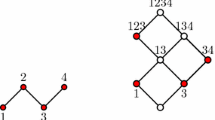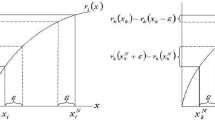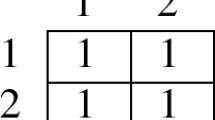Abstract
The extension of set functions (or capacities) in a concave fashion, namely a concavification, is an important issue in decision theory and combinatorics. It turns out that some set-functions cannot be properly extended if the domain is restricted to be bounded. This paper examines the structure of those capacities that can be extended over a bounded domain in a concave manner. We present a property termed the sandwich property that is necessary and sufficient for a capacity to be concavifiable over a bounded domain. We show that when a capacity is interpreted as the product of any sub group of workers per a unit of time, the sandwich property provides a linkage between optimality of time allocations and efficiency.
Similar content being viewed by others
Notes
\(\mathbf{1}_S\) is the indicator of \(S\): it is an \(|N|\)-dimensional vector \((\mathbf{1}_S(1),\ldots ,\mathbf{1}_S(|N|))\) such that \(\mathbf{1}_S(i)=1\) if \(i\in S\) and \(\mathbf{1}_S(i)=0\) otherwise.
We show in Sect. 5 that the results hold for non-monotonic set functions that may obtain negative values as well.
The totally balanced cover of a capacity \(v\) is a capacity \(\hat{v}\) defined by \(\hat{v}(S)=\int ^{cav} \mathbf{1}_S\ dv\), for every \(S\subseteq N\). A capacity \(v\) is totally balanced if \(v=\hat{v}\).
For a vector \(x\in \mathbb R^N\) and a coalition \(S\subseteq N\), by \(x(S)\) we mean the inner product \(\langle x, \mathbf{1}_S \rangle =\sum _{i\in S}x_i\).
References
Anscombe, F.J., Aumann, R.J.: A definition of subjective probability. Ann. Math. Stat. 34, 199–295 (1963)
Azrieli, Y., Lehrer, E.: Extendable cooperative games. J. Public Econ. Theory 9, 1069–1078 (2007)
Biswas, A.K., Parthasarathy, T., Potters, J.A.M., Voorneveld, M.: Large cores and exactness. Games Econ. Behav. 28, 112 (1999)
Bondareva, O.: The theory of the core in an n-person game (in Russian). Vestnik Leningr. Univ. 13, 141–142 (1962)
Choquet, G.: Theory of capacities. Ann. Inst. Fourier 5, 131–295 (1955)
Estévez-Fernández, A.: New characterizations for largeness of the core. Games Econ. Behav. 76, 160–180 (2012)
Lehrer, E.: A new integral for capacities. Econ. Theory 39, 157–176 (2009)
Lehrer, E., Teper, R.: Subjective Independence and Concave Expected Utility, (2014), Mimeo
Lehrer, E., Teper, R.: The concave integral over large spaces. Fuzzy Sets Syst. 16, 2130–2144 (2008)
Lovasz, L.: Submodular functions and convexity. In: Bachem, A., et al. (eds.) Mathematical Programming: The State of the Art, pp. 235–257. Springer, Berlin (1983)
Murofushi, T., Sugeno, M., Machida, M.: Non-monotonic fuzzy measures and the choquet integral. Fuzzy Sets Syst. 64, 73–86 (1994)
Schmeidler, D.: Cores of exact games. J. Math. Anal. Appl. 40, 214–225 (1972)
Schmeidler, D.: Subjective probabilities and expected utility without additivity. Econometrica 57, 571–587 (1989)
Shapley, L.S.: On balanced sets and cores. Nav. Res. Logist. Q. 14, 453–460 (1967)
Shapley, L.S.: Cores of convex games. Int. J. Game Theory 1, 11–26 (1971)
Sharkey, W.W.: Cooperative games with large cores. Int. J. Game Theory 11, 175–182 (1982)
Author information
Authors and Affiliations
Corresponding author
Additional information
Ehud Lehrer: Lehrer acknowledges the support of the Israel Science Foundation, Grant #762/045.
Appendix
Appendix
Proof of Lemma 1
Fix a capacity \(v\). The homogeneity of \(e_v\) is implied by the definition of \(\int ^{cav} \cdot dv\). Now, fix \(x\in Q\) and consider a decomposition of \(x\), \(\sum _{S\subseteq N}\alpha _S \mathbf{1}_S=x\). Letting \(i^*= \arg \max _{i\in \{1,\ldots ,n\}}\) \(x_i\), we get that \(\sum _{S\subseteq N}\alpha _S\ge \sum _{S\subseteq N, i^*\in S} \alpha _S=x_{i^*}=\max x\). Since \(e_v(x)\) is the minimum over all such decomposition, we obtain \(e_v(x)\ge \max x\). \(\square \)
Proof of Lemma 2
Let \(v\) be a capacity defined over \(N\) and \(v_S\) its sub-capacity. If \(v_S\) does not have the sandwich property, then there is an affine function \(f_S(x)=a+\sum _{i\in S}a_ix_i\) (where \(x\in [0,1]^S\)) that dominates \(v_S\), and there is no linear function dominated by \(f_S\) and that is dominating \(v_S\). Denote,
\(b\) is the maximal contribution of a coalition \(B\) in \(N{\setminus }S\) to a coalition \(A\) in \(S\). Define the following affine function over \(Q\), \(f(x)=a+\sum _{i\in S}a_ix_i+ \sum _{i\in N\setminus S}bx_i\). It is clear that \(f\) dominates \(v\). Suppose, to the contrary of the assumption that \(v\) does have the sandwich property and that there exists a linear function \(\ell (x)=\sum _{i\in N}c_ix_i\), dominated by \(f\) and is dominating \(v\). Then, \(\ell _S(x) =\sum _{i\in S}c_ix_i\) is dominated by \(f_S\) and is dominating \(v_S\). This is a contradiction.
On the other hand, if \(v\) has the sandwich property, let \(f_S\) be an affine function that dominates \(v_S\). Define \(f\) in the same way as defined above. By assumption, there is a linear function \(\ell \) that is dominating \(v\) and is dominated by \(f\). The restriction of \(\ell \) to \(S\), \(\ell _S\), is dominating \(v_S\) and is dominated by \(f_S\), implying that \(v_S\) has the sandwich property. \(\square \)
Proof of Claim 1
Suppose that the core of \(v\) is non-empty and let \(\sum \alpha _S\mathbf{1}_S\) be a decomposition of \(\mathbf{1}_N\), then by the Shapley-Bondareva theorem (Bondareva [4] and Shapley [14]), \(\sum \alpha _Sv(S)\le v(N).\) Thus, the decomposition \(\mathbf{1}_N\) of itself is optimal, implying that \(e_v(\mathbf{1}_N)\le 1\), and by Lemma 1, \(e_v(\mathbf{1}_N)= 1\).
Now suppose that \(e_v(\mathbf{1}_N)= 1\). It implies that any sharp decomposition of \(\mathbf{1}_N\), \(\sum \alpha _S\mathbf{1}_S\), satisfies \(S=N\) whenever \(\alpha _S>0\). Thus, the decomposition is in fact \(\mathbf{1}_N\) itself. \(\square \)
Proof of Claim 2
Let \(x\in Q\) and \(\sum \alpha _S\mathbf{1}_S\) be its sharp decomposition. W.l.o.g, \(\alpha _{\{12\}}\le \alpha _{\{13\}},\alpha _{\{23\}}\). Thus we can replace \(\alpha _{\{12\}}\mathbf{1}_{12}+\alpha _{\{13\}}\mathbf{1}_{13}+\alpha _{\{23\}}\mathbf{1}_{23}\) by \(2(\alpha _{\{12\}}\mathbf{1}_{123}+(\alpha _{\{13\}}-\alpha _{\{12\}})\mathbf{1}_{13}+(\alpha _{\{23\}}-\alpha _{\{12\}})\mathbf{1}_{23})\).
We conclude that one may assume that in a sharp decomposition the coefficient of \(\mathbf{1}_{12}\) is \(0.\) Furthermore, based on the total balancedness of \(v\), a similar argument would imply that no two coalitions with positive coefficients in the decomposition are disjoint. Thus, at most one singleton has a positive coefficient and the one that has a positive coefficient, if exists, is included in the other coalitions whose coefficients are positive.
We now show that there is \(i\in N\) that is a member of all coalitions whose coefficients are positive. This shows that \(e(x)= \max x\) and with the help of Theorem 1 completes the proof.
Case 1: \(\alpha _{\{1\}}>0\). Then, \(\alpha _{\{2\}}=\alpha _{\{3\}}=\alpha _{\{23\}}=0\), which means that \(1\in S\) when \(\alpha _{\{S\}}>0\). Case 2: \(\alpha _{\{2\}}>0\). Then, \(\alpha _{\{1\}}=\alpha _{\{3\}}=\alpha _{\{13\}}=0\) implying that \(2\in S\) if \(\alpha _{\{S\}}>0\). Case 3: \(\alpha _{\{3\}}>0\). Similar to the previous case. Finally, Case 4: \(\alpha _{\{i\}}=0\) for every \(i\in N\). Since \(\alpha _{\{12\}}=0\), \(3\in S\) whenever \(\alpha _{S}>0\). This completes the proof. \(\square \)
Proof of Claim 3
By Lovazc [10] (pp. 246–249), when \(v\) is convex for any \(x\in Q\), the Choquet decomposition is optimal. Thus, \(e(x)=\max x\).\(\square \)
Proof of Claim 4
Assume that any sub-capacity of \(v\) has a large core. This implies that \(v\) is totally balanced. Thus, every sub-capacity of \(v\) is totally balanced and has a large core. As such, any sub-capacity is exact (Sharkey [16]), implying that \(v\) is convex (Biswas et al. [3]). By Claim 3, \(v\) has the sandwich property.\(\square \)




